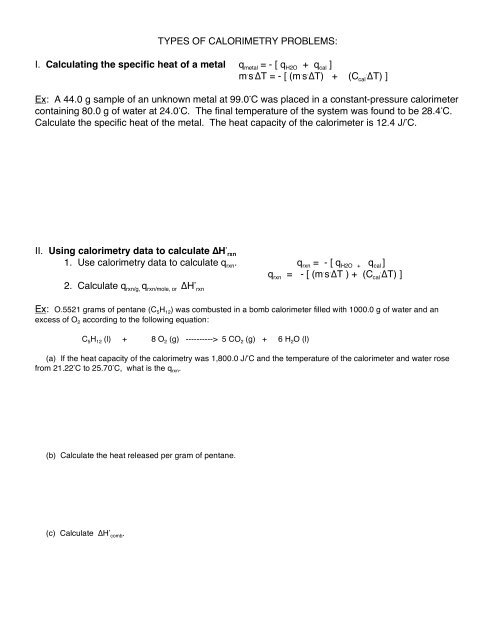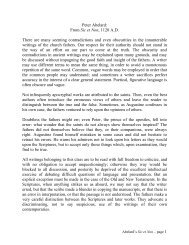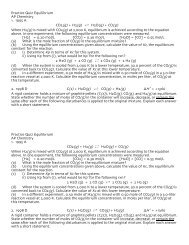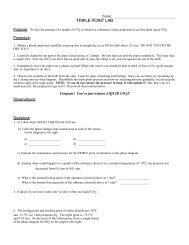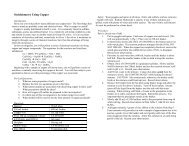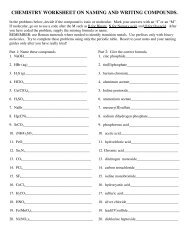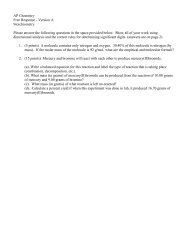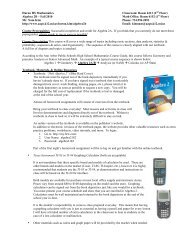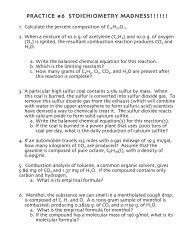TYPES OF CALORIMETRY PROBLEMS: I. Calculating the specific ...
TYPES OF CALORIMETRY PROBLEMS: I. Calculating the specific ...
TYPES OF CALORIMETRY PROBLEMS: I. Calculating the specific ...
You also want an ePaper? Increase the reach of your titles
YUMPU automatically turns print PDFs into web optimized ePapers that Google loves.
<strong>TYPES</strong> <strong>OF</strong> <strong>CALORIMETRY</strong> <strong>PROBLEMS</strong>:<br />
I. <strong>Calculating</strong> <strong>the</strong> <strong>specific</strong> heat of a metal q metal = - [ q H2O + q cal ]<br />
m . s . ∆T = - [ (m . s . ∆T) + (C cal . ∆T) ]<br />
Ex: A 44.0 g sample of an unknown metal at 99.0 • C was placed in a constant-pressure calorimeter<br />
containing 80.0 g of water at 24.0 • C. The final temperature of <strong>the</strong> system was found to be 28.4 • C.<br />
Calculate <strong>the</strong> <strong>specific</strong> heat of <strong>the</strong> metal. The heat capacity of <strong>the</strong> calorimeter is 12.4 J/ • C.<br />
II. Using calorimetry data to calculate ∆H • rxn<br />
1. Use calorimetry data to calculate q rxn . q rxn = - [ q H2O + q cal ]<br />
q rxn = - [ (m . s . ∆T ) + (C . cal ∆T) ]<br />
2. Calculate q rxn/g, q rxn/mole, or ∆H • rxn<br />
Ex: O.5521 grams of pentane (C 5 H 12 ) was combusted in a bomb calorimeter filled with 1000.0 g of water and an<br />
excess of O 2 according to <strong>the</strong> following equation:<br />
C 5 H 12 (l) + 8 O 2 (g) ----------> 5 CO 2 (g) + 6 H 2 O (l)<br />
(a) If <strong>the</strong> heat capacity of <strong>the</strong> calorimetry was 1,800.0 J/ • C and <strong>the</strong> temperature of <strong>the</strong> calorimeter and water rose<br />
from 21.22 • C to 25.70 • C, what is <strong>the</strong> q rxn .<br />
(b) Calculate <strong>the</strong> heat released per gram of pentane.<br />
(c) Calculate ∆H • comb.
III. Using ∆H • rxn (or ∆H • /g of ∆H • /mol) to figure out calorimetry data.<br />
1. Use ∆H • rxn (or q rxn /g or q rxn /mole) to calculate q rxn .<br />
2. Plug q rxn into calorimeter expression and solve for whatever....T i , T f , ∆T, C cal<br />
q rxn = - [ q H2O + q cal ]<br />
q rxn = - [ (m . s . ∆T ) + (C cal . ∆T) ]<br />
Ex: 0.600 g of B 5 H 9 (s) was combusted in a calorimeter containing 1,000.0 g of H 2 O. Predict ∆T<br />
of water. Ccal = 1760 J/•C.<br />
2 B 5 H 9 (s) + 12 O 2 (g) ----> 5 B 2 O 3 (g) + 9 H 2 O (l) ∆Hrxn = -9080 kJ


